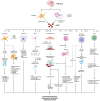Extracellular cold-inducible RNA-binding protein in CNS injury: molecular insights and therapeutic approaches
- PMID: 39838468
- PMCID: PMC11752631
- DOI: 10.1186/s12974-025-03340-7
Extracellular cold-inducible RNA-binding protein in CNS injury: molecular insights and therapeutic approaches
Abstract
Central nervous system (CNS) injuries, such as ischemic stroke (IS), intracerebral hemorrhage (ICH) and traumatic brain injury (TBI), are a significant global burden. The complex pathophysiology of CNS injury is comprised of primary and secondary injury. Inflammatory secondary injury is incited by damage-associated molecular patterns (DAMPs) which signal a variety of resident CNS cells and infiltrating immune cells. Extracellular cold-inducible RNA-binding protein (eCIRP) is a DAMP which acts through multiple immune and non-immune cells to promote inflammation. Despite the well-established role of eCIRP in systemic and sterile inflammation, its role in CNS injury is less elucidated. Recent literature suggests that eCIRP is a pleiotropic inflammatory mediator in CNS injury. eCIRP is also being evaluated as a clinical biomarker to indicate prognosis in CNS injuries. This review provides a broad overview of CNS injury, with a focus on immune-mediated secondary injury and neuroinflammation. We then review what is known about eCIRP in CNS injury, and its known mechanisms in both CNS and non-CNS cells, identifying opportunities for further study. We also explore eCIRP's potential as a prognostic marker of CNS injury severity and outcome. Next, we provide an overview of eCIRP-targeting therapeutics and suggest strategies to develop these agents to ameliorate CNS injury. Finally, we emphasize exploring novel molecular mechanisms, aside from neuroinflammation, by which eCIRP acts as a critical mediator with significant potential as a therapeutic target and prognostic biomarker in CNS injury.
Keywords: CNS injury; DAMPs; Efferocytosis; Intracerebral hemorrhage; Ischemic stroke; Neuroinflammation; Neuronal death; Therapeutics; Traumatic brain injury; eCIRP.
© 2025. The Author(s).
Conflict of interest statement
Declarations. Ethics approval and consent to participate: Not applicable. Consent for publication: Not applicable. Competing interests: The authors declare no competing interests.
Figures
Similar articles
-
Extracellular CIRP dysregulates microglial efferocytosis in ischemic stroke via the TLR4/miR-155/MafB axis.Res Sq [Preprint]. 2025 Jul 31:rs.3.rs-7223452. doi: 10.21203/rs.3.rs-7223452/v1. Res Sq. 2025. PMID: 40766256 Free PMC article. Preprint.
-
Uncommon Non-MS Demyelinating Disorders of the Central Nervous System.Curr Neurol Neurosci Rep. 2025 Jul 1;25(1):45. doi: 10.1007/s11910-025-01432-8. Curr Neurol Neurosci Rep. 2025. PMID: 40591029 Review.
-
The Lived Experience of Autistic Adults in Employment: A Systematic Search and Synthesis.Autism Adulthood. 2024 Dec 2;6(4):495-509. doi: 10.1089/aut.2022.0114. eCollection 2024 Dec. Autism Adulthood. 2024. PMID: 40018061 Review.
-
Systemic Inflammatory Response Syndrome.2025 Jun 20. In: StatPearls [Internet]. Treasure Island (FL): StatPearls Publishing; 2025 Jan–. 2025 Jun 20. In: StatPearls [Internet]. Treasure Island (FL): StatPearls Publishing; 2025 Jan–. PMID: 31613449 Free Books & Documents.
-
Systemic pharmacological treatments for chronic plaque psoriasis: a network meta-analysis.Cochrane Database Syst Rev. 2021 Apr 19;4(4):CD011535. doi: 10.1002/14651858.CD011535.pub4. Cochrane Database Syst Rev. 2021. Update in: Cochrane Database Syst Rev. 2022 May 23;5:CD011535. doi: 10.1002/14651858.CD011535.pub5. PMID: 33871055 Free PMC article. Updated.
Cited by
-
Extracellular Cold-Inducible RNA-Binding Protein: Progress from Discovery to Present.Int J Mol Sci. 2025 Apr 9;26(8):3524. doi: 10.3390/ijms26083524. Int J Mol Sci. 2025. PMID: 40332009 Free PMC article. Review.
-
Extracellular CIRP dysregulates microglial efferocytosis in ischemic stroke via the TLR4/miR-155/MafB axis.Res Sq [Preprint]. 2025 Jul 31:rs.3.rs-7223452. doi: 10.21203/rs.3.rs-7223452/v1. Res Sq. 2025. PMID: 40766256 Free PMC article. Preprint.
References
-
- Thapa K, Khan H, Singh TG, Kaur A. Traumatic brain injury: mechanistic insight on pathophysiology and potential therapeutic targets. J Mol Neurosci. 2021;71(9):1725–42. - PubMed
-
- Zhang BW, Sun KH, Liu T, Zou W. The crosstalk between immune cells after Intracerebral Hemorrhage. Neuroscience. 2024;537:93–104. - PubMed
-
- Sun Y, Sun W, Liu J, Zhang B, Zheng L, Zou W. The dual role of microglia in intracerebral hemorrhage. Behav Brain Res. 2024;473:115198. - PubMed
Publication types
MeSH terms
Substances
Grants and funding
LinkOut - more resources
Full Text Sources


